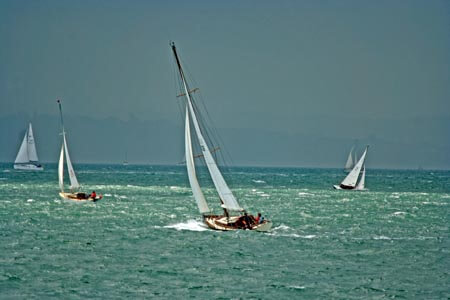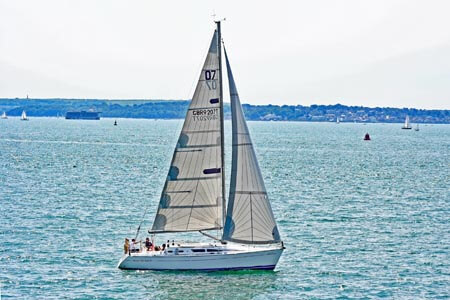
Sailing Portsmouth and The Solent
Embark on a Sailing Adventure in Portsmouth, the gateway to The Solent, one of the World's Premier Sailing Destinations! Nestled alongside the famous Solent waters, Portsmouth offers an unmatched sailing experience, making it the ultimate haven for both beginners and seasoned sailors. Explore the thrill of the open sea, indulge in exhilarating water sports, and immerse yourself in the vibrant maritime culture.
Set against the picturesque backdrop of The Solent, Portsmouth boasts proximity to the renowned Isle of Wight, creating a sheltered paradise for inshore sailing, windsurfing, kite surfing, canoeing, and leisurely cruising. Discover the perfect blend of excitement and tranquility on these inshore waters.
Every year, the Isle of Wight becomes the epicentre of sailing excitement, hosting the prestigious Cowes Week sailing event in August and the exhilarating Round the Island Race in July. These events showcase the region's rich maritime heritage and provide thrilling spectacles for sailing enthusiasts.
In Portsmouth, sailing isn't just a pastime; it's a passion woven into the city's fabric. Home to the esteemed Ben Ainslie Racing and the British America's Cup INEOS Team UK, Portsmouth takes pride in its affiliation with the prestigious America's Cup sailing event.
For more detailed information on Portsmouth's vibrant sailing community, premier Sailing Clubs, and well equipped Marinas, click on the following links: Portsmouth Sailing Clubs and Portsmouth Marinas. Seize the opportunity to navigate the seas, experience the thrill of the wind in your sails, and create unforgettable memories in Portsmouth, where sailing dreams set sail.

Portsmouth Harbour
Portsmouth Harbour is a natural harbour located on the southern coast of England, serving as a major naval port for centuries. It is home to HM Naval Base Portsmouth, one of the oldest and largest naval bases in the UK. The harbour is known for its deep waters, which accommodate large ships and ferries. Surrounding the harbour are notable landmarks, including the Spinnaker Tower and historic dockyards that house famous ships like HMS Victory and HMS Warrior. Portsmouth Harbour is also a busy hub for ferries to the Isle of Wight, Europe, and further afield. Its rich maritime history and bustling waterfront make it a key part of the city’s identity.
Portsmouth Harbour is a roughly triangular natural harbour, each of the three sides is approximately two and a half miles long. Portsmouth Harbour is home to Portsmouth Naval Base, Portsmouth International Port and a commercial dock and is therefore very busy with maritime traffic. Vessels over 20m in length have to enter and leave Portsmouth Harbour in the main channel, and must have permission from the Queen's Harbour Master (QHM). QHM controls shipping on VHF Ch11.
- Restricted Areas: Portsmouth Harbour contains restricted areas around naval docks and military vessels. These zones are clearly marked, and vessels must not enter these areas.
- Speed Limits: A general speed limit of 10 knots applies within Portsmouth Harbour to minimise wash and ensure safety for all users. In smaller areas, like near marinas, speed limits can be lower.
- Navigation and Channels: Commercial and military vessels have right of way in the main channels. Leisure sailors must stay out of these lanes as much as possible and must yield to larger vessels.
- Traffic Separation Schemes: Near the harbour entrance, designated routes for inbound and outbound vessels are in place to manage the traffic. It’s important to follow these schemes to avoid collisions.
- Radio Communications: Mariners should monitor VHF Channel 11 (Portsmouth Harbour Control) for updates on naval movements, commercial traffic, or any warnings.
- Naval Vessels: When naval vessels are entering or leaving the harbour, there may be temporary restrictions, including complete closures of parts of the harbour. Keep a safe distance from these vessels at all times.
- Anchoring: Anchorage is prohibited in certain areas, especially around commercial and military installations.

The Solent
The Solent is a strait that separates the Isle of Wight from mainland England, specifically from Hampshire. It stretches around 20 miles and is known for its strong tidal currents. The Solent is a major waterway for maritime traffic, including commercial shipping and recreational sailing, and it hosts key ports such as Portsmouth and Southampton. It is also famous for yachting and maritime events like Cowes Week. The area is rich in maritime history and serves as an important natural habitat, with several conservation areas along its coastline.
The Solent is 15 miles long and varies in width between 21 to 3 miles due to the undulating shape of its opposing coasts.
Within the Solent, strong currents flow through the Hurst Narrows (1.8 metres per second on spring tides) at the western entrance to the Solent (Velegrakis 1994).
However, at the entrances to Portsmouth Harbour, Langstone Harbour and Chichester Harbours, surface currents may reach in excess of 3 metres per second on a full spring ebb (Admiralty Chart 3418).
Separation zones: In busy areas, such as the shipping lanes near Southampton, separation schemes are in place to guide vessels and reduce the risk of collision. Leisure sailors must stay clear of these areas.
- Speed limits: Speed restrictions apply in certain areas to prevent accidents and minimise wash that could affect smaller boats or sensitive shorelines.
- Right of way: Commercial vessels, including ferries and large ships, generally have right of way in the Solent, and leisure sailors must yield to them.
- Strong tides and currents: The Solent has strong tidal currents, especially around the Isle of Wight and near Portsmouth, requiring sailors to have good knowledge of tidal flows.
- Local regulations: Certain areas, like the entrance to Portsmouth Harbour, have specific rules or exclusion zones for naval and military activity.
Sailors should be familiar with local charts, tide tables, and Solent-specific regulations to ensure safe navigation.

Langstone Harbour
Langstone Harbour is a large natural harbour located between Portsmouth and Hayling Island on the south coast of England. It serves as a sheltered body of water and is known for its rich wildlife and scenic beauty. The harbour is an important ecological site, designated as a Site of Special Scientific Interest (SSSI), a Special Protection Area (SPA), and a Ramsar wetland due to the diverse bird species that use it as a feeding and breeding ground.
Langstone Harbour is less commercial than neighbouring Portsmouth Harbour, primarily used for leisure activities such as sailing, kayaking, and fishing. Several sailing clubs operate in and around the harbour, attracting local enthusiasts. The surrounding area is popular with walkers and birdwatchers, with nature reserves and trails offering scenic views.
Its relatively shallow waters and tidal flats make it an important location for wildlife conservation, particularly for migrating birds. Langstone Harbour also holds historical significance, with remains of old fortifications and traces of Roman occupation in the region.
- Speed Limits: There is a general speed limit of 10 knots within the harbour, which applies to all vessels to reduce wake and protect wildlife. In the more sensitive areas, such as close to shorelines and within designated ecological zones, slower speeds may be required.
- Navigation: Vessels must keep to the deeper channels marked by buoys and avoid shallow tidal flats. Boaters should be aware of tides, as parts of the harbour become inaccessible at low water.
- Environmental Protection: Boaters are encouraged to avoid disturbing wildlife, especially birds, and are required to respect protected areas such as mudflats and saltmarshes. Anchoring in sensitive ecological areas is discouraged or prohibited.
- Water Sports Zones: Specific areas are designated for activities like windsurfing, kitesurfing, and kayaking to minimise conflict with other water users and protect wildlife.
- Mooring: Only moor in designated areas. Unauthorised mooring is not allowed, and long-term mooring often requires permission from the Langstone Harbour Board.
- Waste Disposal: Vessels are not permitted to discharge waste into the harbour, and proper facilities should be used for waste disposal.
These rules are enforced by the Langstone Harbour Board, which also offers guidance on safe and environmentally responsible boating practices.

Useful Marine Contacts
Solent Coastguard Maritime Rescue
- In an Emergency - Contact the Coastguard using 999
- If at sea call on VHF channel 16 or depress the RED distress button on your DSC controller
- For routine traffic and other information Telephone: 02392 552100 or call on VHF 67
- Digital Selective Calling MMSI 002320011
Portsmouth Lifeboat Station
- In an Emergency - Contact the Coastguard using 999
- Address: Ferry Road, Southsea, Hampshire, PO4 9LY
- Telephone: 02392 814811
Gosport and Fareham Inshore Rescue Service (GAFIRS)
- Independent Lifeboat based in Gosport on call 24 / 365
- area of coverage is from Hillhead Harbour to South Parade Pier, including all of Portsmouth Harbour
- Address: GAFIRS, Lifeboat Lane, Gosport, Hampshire, PO12 2TR
- Telephone: 02392 584017 (HQ - Operational Calls)
- Website: GAFIRS
- In an Emergency - Contact the Coastguard using 999
Langstone Harbour
- Langstone Harbour Board, Ferry Road, Hayling Island, Hampshire, PO11 0DG
- Tel: 02392 463419
- VHF Ch12 and 16 (Working hours)
- Email: admin@langstoneharbour.org.uk
King's Harbour Master, Portsmouth
- Address: Semaphore Tower, HM Naval Base, Portsmouth, PO1 3LT
- Telephone: 02392 723694
- Customs: If you are arriving or departing from any country outside the EU or the Channel Islands, you must complete the Customs form C1331.
- HM Customs Portsmouth Telephone: 02392 852148